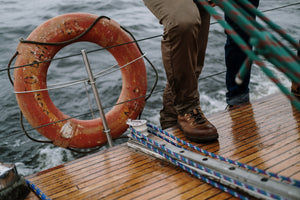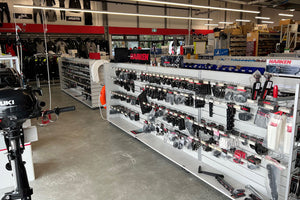
Caring For Your Ropes
Careful use and storage of your boats lines can help preserve the strength and longevity of your ropes. This handy guide from Marlow Ropes shows you how to get the most from your lines, and how to spot lines that have been damaged or worn out.
Check out our range of Marlow ropes here
STORAGE
Ropes should be stored in a suitable clean, dry place out of direct sunlight and away from extreme temperature. Do not store ropes on dirty floors or drag over rough ground – dirt and grit can work between the fibres and cause abrasion damage. Keep ropes
COILING
3 Strand ropes may become damaged if they are taken from a coil the wrong way. If this happens turn the coil over and withdraw the rope from the centre – the rope should run correctly without kinking. Braided ropes can have excessive twist imparted into them by incorrect handling. Ideally these ropes should be “hanked” in a figure of 8 fashion avoids putting twist in and will ensure free running when deployed. If supplied on a reel, this must be allowed to rotate freely on a central pin so that the rope may be drawn off from the top layer. Never take the rope from a reel lying on its side unless placed onto a turntable.
CHEMICALS
The materials used in the construction of synthetic fibre ropes can be affected by exposure to chemicals, often this will reduce the strength of the rope. Each of the materials is affected differently by different chemicals. If a rope has been exposed to a chemical that may have caused damage it should be retired from use. Chemical damage often appears as discoloured or powdery / dusty yarns however the rope can be significantly weakened with no visible effects.
HEAT
Exposure to elevated temperatures can change the properties of a rope. In some cases these changes can be beneficial e.g. Pre stretching and heat setting. More often the effects of heat will be to reduce the strength and damage the rope. It is important to avoid exposing a rope to localised heat sources or elevated temperatures. This must be ensured both in use and when the rope is stored
FRICTION GENERATED HEAT
When a rope is used on a winch or capstan it is possible to generate enough heat through friction to melt or fuse the fibres of the rope resulting in a reduction in performance. To avoid this care should be taken to avoid excessive slipping or surging. Many ropes are designed specifically to withstand friction generated heat.
U.V. RADIATION
All the materials used in the construction of synthetic fibre ropes are to a greater or lesser extent effected by exposure to UV radiation. Wherever possible try to limit the exposure of the rope to sunlight. Smaller ropes are effected more than large ropes since they have a larger exposed surface area in proportion to their volume. The effect of UV radiation on a rope is directly linked to the inherent UV properties of the yarn used in design and manufacture.
ABRASION
All ropes can be damaged if they are exposed to abrasive surfaces or sharp edges. Care should be taken to try and avoid running a rope over any non-moving surface. If the rope is run over sheaves or rollers they should be kept in good order with a smooth surface and they must be free to rotate. Abrasion can also be caused by the ingress of particles into the rope. Conditions where a rope will come into contact with sand, dirt, grit and other abrasive particles should be avoided. Damage caused by this type of abrasion may not be visible on the outside of a rope yet the strength may be severely reduced.
EXPOSURE TO WATER
The properties of nylon in particular are changed slightly when they become wet. The fibre shrinks, the strength is reduced by up to 15% and the extension increases. You will notice a general stiffening of the rope. Other materials used in rope making are largely unaffected by even prolonged exposure to water
TERMINATION TYPES
SPLICES: Most Marlow ropes can be spliced, this is normally the preferred method of termination. A good splice using the recommended method should not reduce the strength of a rope by more than 10%.

KNOTS: A knot is the simplest way to terminate or join a rope, but will reduce the strength of the rope, sometimes very significantly. This loss is caused by the tight bends and compression found in any knot. The amount a rope will be weakened will depend on the knot, type of rope and the material from which it is made but can be up to 60%

SEWN EYE: A Sewn eye is made using an industrial sewing machine and is usually only done at the factory or by a specialist. Sewing has advantages over a splice in that it allows for easy inspection and clear retirement criteria. However, a sewn eye's strength is a factor of the stitching pattern and thread and not related to the strength of the rope so in many cases will not be as strong as a splice. Cosmetically it is also not as attractive as a good splice.

It is important that a rope is regularly inspected to ensure that it is undamaged and is still fit for service. The entire length of rope should be examined. The following are some of the points that should be checked. The degree to which any of the following may be allowed before the rope is retired will be dependant on the assumptions made when the rope and safety factors were determined.
INSPECTING YOUR ROPES
It is important that a rope is regularly inspected to ensure that it is undamaged and is still fit for service. The entire length of rope should be examined. The following are some of the points that should be checked. The degree to which any of the following may be allowed before the rope is retired will be dependant on the assumptions made when the rope and safety factors were determined
External abrasion

When a multifilament rope is subjected to abrasion then the outer filaments will quickly become broken and a furry finish will develop. This furry layer will protect the yarns underneath preventing further abrasion. If this condition does not stabilise and continues to develop then there may be excessive abrasion that could lead to significant strength loss.
As the surface of a rope wears some of the filaments will break, this will result in a fluffy/fuzzy appearance. This provides a cushioning layer that protects the fibres underneath and stabilises the abrasion process.
This type of abrasion is typically caused by the environment the rope is used in and can be reduced by ensuring the rope is clean and sheaves etc are in good condition
Internal abrasion

Glazing

If a rope has been subjected to excessive heat then there may be glazed or glossy areas of rope. The glazing is caused when the yarns melt, if this has happened then the nearby yarns will also have been exposed to elevated temperatures and will have been affected. This type of damage is often seen if ropes slip on winch barrels or capstans.
Discolouration

Inconsistencies




